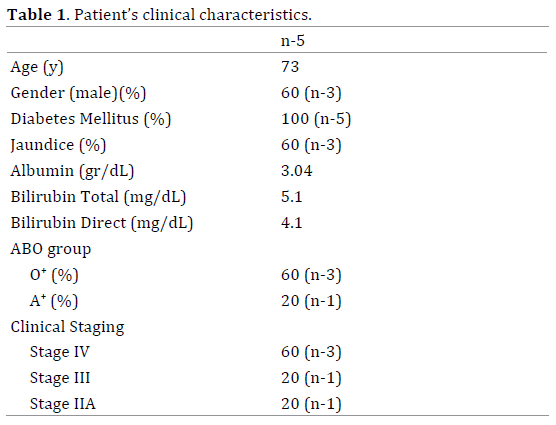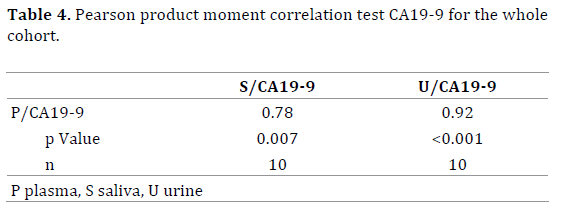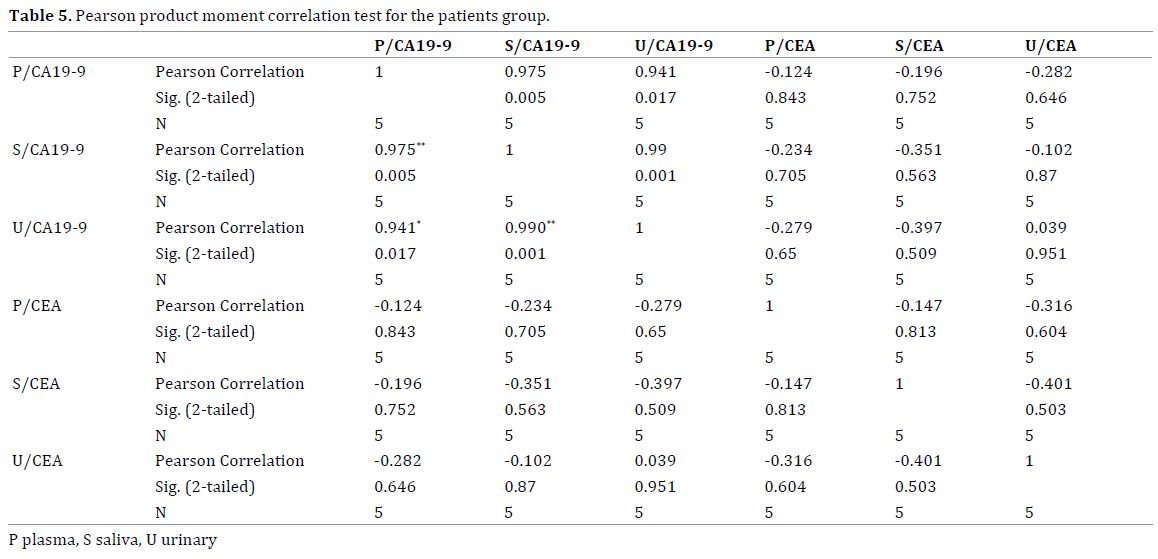- (2016) Volume 17, Issue 1
Offir Ben-Ishay1, Shirley Or Haim1, Marielle Kaplan2, Yoram Kluger1
Department of Surgery1 and the Clinical Laboratories division2, Rambam Health Care Campus, Haifa, Israel
Received August 06th, 2015-Accepted October 06th, 2015
Context Ductal adenocarcinoma of the pancreas is the fifth leading cause of cancer related deaths in the European Union. Tumor markers CA19-9 and carcinoembryonic antigen are important components in decision making and follow-up of patients diagnosed with this disease. These tumor markers were found to be elevated not only in the serum but also in other body fluids in patients with malignant lesions of the parotid gland and the urinary tract. Objectives The current preliminary study evaluates the correlation between serum CA19-9 and carcinoembryonic antigen levels with those obtained in saliva and urine of patients with ductal adenocarcinoma of the pancreas. Methods We have prospectively collected blood, urine and saliva of patients with biopsy proven ductal adenocarcinoma of the pancreas and documented elevated serum CA19-9 and/or carcinoembryonic antigen levels. In addition we have collected body fluids of healthy controls for normal values levels definition. Levels of tumor markers were measured using an immunochemistry analyzer based on an electrochemiluminescence sandwich immunoassay. Results CA19-9 and carcinoembryonic antigen were both detected in the saliva and urine of patients and controls. CA19-9 levels of the healthy controls were normal with a significant increase in serum CA19-9 (p-0.008) of the patient's group. Pearson product moment correlation test demonstrated a linear and consistent correlation between serum CA19-9 and saliva and urine levels. Conclusions The current pilot study demonstrated linear correlation of serum levels of CA19-9 with those measured in the saliva and urine of patients with ductal adenocarcinoma of the pancreas. These results encourage us to undertake a larger cohort study to confirm our results and standardize the detected levels in these body fluids.
carbohydrate antigen 199, human; Carcinoembryonic Antigen; Pancreatic Neoplasms; Saliva; Tumor Markers, Biological; Urine
CEA carcinoembryonic antigen; ECLIA Electrochemiluminescence Immunoassay
Ductal adenocarcinoma of the pancreas is the fifth leading cause of cancer related deaths in the European Union [1] and its incidence is on the rise. Early diagnosis is of utmost importance for survival in this fatal disease.
Carbohydrate antigen 19-9 (CA19-9) is the most validated and used serum tumor marker for the diagnosis, management strategy, decision making, determination of prognosis, post-operative surveillance and monitoring of therapy in patients with pancreatic cancer. Other serum based markers namely carcinoembryonic antigen (CEA) and CA 242 are also used.
CA19-9 and CEA [2-4] were both found to be elevated in serum of patients with cancers of the gastrointestinal tract. These tumor markers were also found in other body fluids e.g. saliva and urine and were previously described as potential markers for the detection of parotid and urothelial malignancies [5-7].
We hypothesized that the elevation of serum CA19- 9 and or CEA in patients with ductal adenocarcinoma of the pancreas may be reflected in high saliva and/ or urine markers levels. We have therefore designed a prospective pilot trial to examine the levels of CA19-9 and CEA in these body fluids in patients diagnosed with ductal adenocarcinoma of the pancreas.
With the approval of the local ethics committee of the Rambam Health Care Campus in Haifa, Israel (RMB 0279- 14) we have prospectively collected blood, urine and saliva of patients with biopsy proven ductal adenocarcinoma of the pancreas and elevated serum tumor markers levels. In addition we have collected body fluids of healthy controls to evaluate the detectability and the normal levels of CA19- 9 and CEA in healthy volunteers.
Clinical Materials
Five patients with biopsy proven ductal adenocarcinoma of the pancreas and elevated serum CA19-9 were recruited for the study. Although CEA was previously reported to be elevated in patients with ductal adenocarcinoma of the pancreas, an elevated CEA in this cohort of patients was infrequent. Therefor elevated CEA levels were not mandatory inclusion criteria. Five healthy volunteers were recruited as control group. All patients and controls signed an informed consent approved by the local ethics committee. Demographics and clinical parameters of the patients were also collected.
Reagents and Methods
Samples (serum, spot urine and saliva) were analyzed for their CEA and CA 19-9 levels using commercial assays (Roche diagnostics, Mannheim, Germany) that were ran on an immunochemistry analyzer (COBAS E411, Roche diagnostics, Mannheim, Germany).Method of detection is based on an electrochemiluminescence (ECLIA) sandwich immunoassay. Regarding CEA the lower limit of detection is 0.2 ng/mL, regarding CA 19-9 the lower limit of detection is 0.6 U/mL.
Statistical Methods
Statistical analysis was performed with SPSS version 13.0. Values are expressed in median if not specified otherwise. Mann Whitney U test was used for comparison of medians. Pearson Product Moment Correlation (PPMC) test was applied to evaluate the correlation between values of tumor markers in the different body fluids in the two groups. P value <0.05 was considered significant. Rho values between 0.5-1 were considered high correlation, 0.3-0.5 medium correlation and 0.1-0.3 low correlation.
Blood, urine and saliva were collected from 5 patients with a biopsy proven diagnosis of ductal adenocarcinoma of the pancreas and of 5 healthy volunteers. Table 1 depicts demographics and clinical characteristics of the patients included in the study.

Saliva and urine of all patients in the two groups had detectable levels of CA19-9 and we have affirmed that detection of these tumor markers in those body fluids is feasible.
Table 2 depicts the levels CA19-9 in plasma, saliva and urine of the two groups. Levels of the healthy controls were normal with a significant increase in serum CA19-9 (p-0.008) of the patient's group. Median serum CEA levels were also higher and statistically significant in the patient's group. (Table 3) CEA levels in saliva were elevated in both patients and controls with no significant difference 279 μ/mL (75.3-2191) and 155 μ/mL (66.8-212) respectively (p-0.31).


Pearson product moment correlation (PPMC) test was applied for the whole group, a positive linear correlation was found between CA19-9 levels in the plasma to those measured in the saliva and urine (r-0.78, p-0.007; r-0.92, p<0.001 respectively) (Table 4). No such correlation was found to CEA levels.

PPMC test was then applied to the control group. In this group where serum CA19-9 levels were not elevated no linear correlation was found for both tumor markers with the levels in the saliva or urine.
When PPMC was applied for the patient's group a positive linear correlation was found between serum levels of CA19-9 and levels of CA19-9 in the saliva and urine (r- 0.975, p-0.005; r-0.941, p-0.02 respectively) (Table 5). Such correlation was not found for CEA levels.

CA19-9 is a glycolipid antigen. In the serum it exists as a high molecular weight mucinous glycoprotein which contains the sialyated Lewis epitope lacto-N-fucopentose II. (8)
CA19-9 is present on the epithelium of the fetal stomach, intestine, liver and pancreas. Traces may be detected in adult's normal gastrointestinal tract and lung tissue. Greater amounts are found in saliva, bile, ovarian cyst fluid, seminal fluid, amniotic fluid, gastric and duodenal secretion and urine. Carcinoembryonic antigen (CEA) is an antigen-specific specie human embryonic acidic glycoprotein, present in the surface of tumors derived from the endoderm cells, as a structure protein of the cell membrane that has a role in cell adhesion. Its molecular weight is 200 kD. CEA is present in embryonic tissue and in extracts from normal colonic washings. Both CA19-9 and CEA were validated as serum tumor markers throughout the management of patients with ductal adenocarcinoma of the pancreas.
Dyckhoff et al. (2) demonstrated correlation between malignant neoplasms of the parotid gland and elevated CA19-9 levels in patient's saliva and concluded that preoperative evaluation of saliva CA19-9 in patients with parotid tumors may differentiate between malignant and benign tumors. He et al (9) correlated well between saliva CEA levels and oral cavity tumors. Roy et al. (3) found that CA19-9 may be also used as a screening parameter for the diagnosis of low grade and early stages of transitional cell carcinoma of the urinary bladder.
Results of these previous studies encouraged us to hypothesize the existence of a linear and consistent correlation between CA19-9 and CEA levels in the saliva and urine with those presented in serum of patients with ductal adenocarcinoma of the pancreas. Increase in the incidence and the fatality of pancreatic cancer deliver sincere need for new screening methods. Therefor an easily accessible body fluid with a highly sensitive and specific screening method may enhance the compliance of physicians, insurance companies and the public for such analysis.
The current pilot study demonstrated linear correlation of serum levels of CA19-9 with those measured in the saliva and urine of patients with ductal adenocarcinoma of the pancreas. The PPMC test applied showed a relatively high and significant linear correlation between the measured levels of CA19-9 in these body fluids and that of the serum, that confirms our initial hypothesis.
The study is limited by its small cohort; a fact that limits the linearity of the correlation between the different body fluids mostly in the healthy controls. On the other hand we believe that the extreme importance of the topic merits further evaluation by a larger prospective study.
Therefore we conclude that measurement of CA19-9 and CEA in the urine and saliva is practicable. Furthermore our pilot study show that a linear correlation exists between serum, saliva and urine levels of both CA19-9 in patients with ductal adenocarcinoma of the pancreas. A larger cohort study is undertaken now to confirm the current results and to attempt to standardize the results of saliva and urinary tumor markers. Sampling of urine or saliva of patients with pancreatic adenocarcinoma rather than serum may render this important feature of diagnosis and follow-up more cost effective.
The authors have no conflict of interest to disclose.